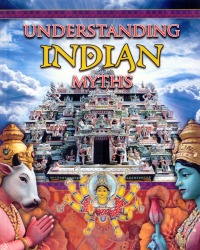| ________________
CM . . .
. Volume XIX Number 26. . . .March 8, 2013
excerpt:
Now numbering eight titles, the "Myths Understood" series is based on the premise that, in order to understand the myths of a particular culture or society, one must first understand the times and the settings in which they were told or written. Like the other titles in the series, Understanding Indian Myths has seven similar chapters and begins with a general description of what myths are- a written or spoken narrative which helped people to explain the unknown, the natural world (such as the reasons for seasons, weather, or the origins of the stars and planets, and plants and animals) and tragic events, such as natural disasters. Myths also set standards for behavior. Following the introductory chapter, the book covers Ancient India, its religions and gods, the natural world, daily life, trade and warfare and the modern-day legacy of Ancient India. The myths presented are fairly well matched with the topics within each chapter. For example, in the chapter devoted to the various religions in India, there is a myth related to the religious festival of Diwali, another whose theme is the importance of karma in the concept of reincarnation, yet another about the birth of Mahavira, who is believed to have been the founder of the Jain faith. Unfortunately, the main body of the text and the text of the myths, themselves, seem to be slightly disparate, the former more interesting and well-written than the latter which are rather lackluster and read more like brief summaries of myths than actual stories which would sustain a readerís or a listener's interest. Perhaps a little less history and a bit more effort to make the myths more enjoyable would be in order. Several text boxes provide additional information as do "Link to Today" boxes which demonstrate the Indian culture's influence on present-day life. Some examples of this include the Hindu-Arabic number system, spices imported from India (the book states that India accounts for 85 per cent of the world's production of spices), and Mahatma Gandhi's peaceful leadership style which influenced people seeking equal rights for African-Americans in the United States in the 1960s. Illustrations consist of maps and colour photographs of ancient art as well as current day practices, such as a traditional wedding ceremony, and a parade to celebrate the birth of Ganesh, the god of new endeavours. One interesting custom that is related to a myth is the giving of a rakhi (bracelet) as a sign of friendship. This custom originated with the god Indra's wife who gave him a lucky bracelet to protect him in battle. A time chart, a table of contents, a glossary and an index are provided along with a list of books and websites for further study. Recommended with reservations. Gail Hamilton is a former teacher-librarian in Winnipeg, MB.
To comment
on this title or this review, send mail to cm@umanitoba.ca.
Copyright © the Manitoba Library Association. Reproduction for personal
use is permitted only if this copyright notice is maintained. Any
other reproduction is prohibited without permission.
NEXT REVIEW |
TABLE OF CONTENTS FOR THIS ISSUE
- March 8, 2013
AUTHORS |
TITLES |
MEDIA REVIEWS |
PROFILES |
BACK ISSUES |
SEARCH |
CMARCHIVE |
HOME |
